Tuesday, 19 June 2012: The tapestry and the cathedral
Written June 2012
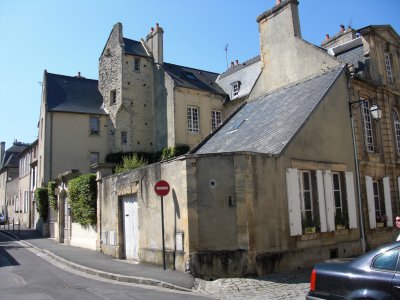
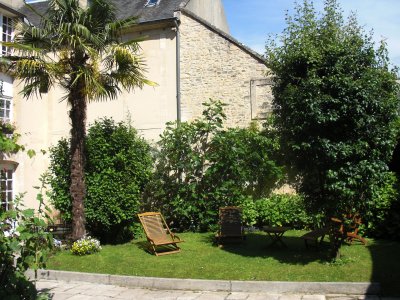 Here's what the Manoir Sainte Victoire looked like from the outside. I don't know whether the two-windowed section with the flat chimney nearest the camera is part of it, but the garden whose vines are overflowing the wall, the three sections beyond it, and the larger section at right angles to them are. Our room was in the bottom of the leftmost section and CJ's one floor up a spiral stone staircase in the middle section.
Here's what the Manoir Sainte Victoire looked like from the outside. I don't know whether the two-windowed section with the flat chimney nearest the camera is part of it, but the garden whose vines are overflowing the wall, the three sections beyond it, and the larger section at right angles to them are. Our room was in the bottom of the leftmost section and CJ's one floor up a spiral stone staircase in the middle section.
Our room looked out into this courtyard, through which we had to pass to get to the dining room for breakfast. To the right of our door as we walked out was a raspberry bed, and across the garden, against the wall, were a fig tree and a pear tree.
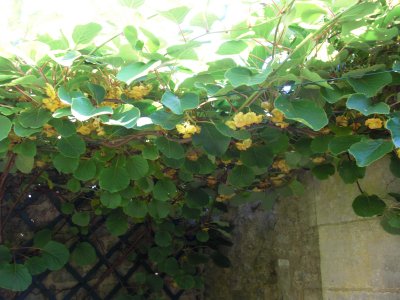
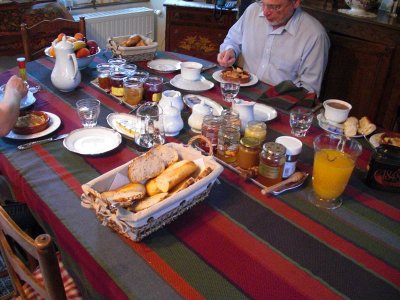 I'm pretty sure that this vine, in profuse bloom in a corner of the wall (just to the right of the photo above) is a kiwi.
I'm pretty sure that this vine, in profuse bloom in a corner of the wall (just to the right of the photo above) is a kiwi.
And this is what breakfast looks like there. Besides the bread, pastries, coffee, whole fruit, OJ (which CJ declared outstanding), salted and unsalted butter, and (count 'em) fourteen (!) kinds of jam (all made either in house or by local artisans, "except the British stuff," said the hostess, waving a dismissive hand toward the Nutella and orange marmelade), we were each presented with an individually baked apple crumble, fresh from the oven, into which a few raspberries had been baked (the second morning, the crumble was replaced by a large salad of fresh fruit). Wow.
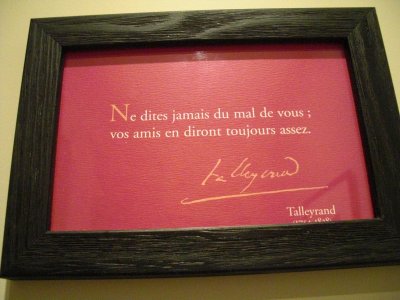
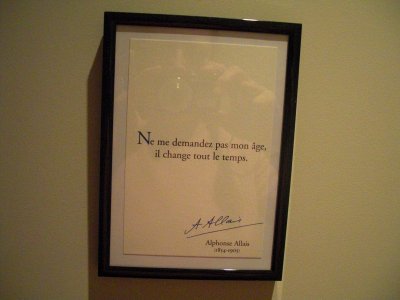 The place really is charming. Each bathroom is decorated with small framed quotations. The one on the left, from Talleyrand, was in ours. It says "Never speak ill of yourself; your friends will do enough of that." The other was in CJ's bathroom (she's in the Miro room) and is from Alphonse Allais (whose book of humorous short stories I had just finished reading. It says, "Don't ask me my age; it changes all the time." Others were (in my translations) "Music begins where the power of words leaves off" (Richard Wagner); "An egotist is someone who doesn't think about me" (Eugène Labiche, 1815-1888); "Elles sont bien noires, les pensées des nuits blanches," (J. de Goncourt, 1810-1870) (meaning "They are very black, the thoughts of white nights"; the French call a sleepless night a "white night"; I assume this is the same Goncourt for whom the literary prize is named), and "Without music, life would be an error" (Friedrich Nietzsche, 1844-1900). Partway up the stairs to CJ's room, in a stone alcove in the wall, was a small collection of books, in French and English, for the reading pleasure of the guests.
The place really is charming. Each bathroom is decorated with small framed quotations. The one on the left, from Talleyrand, was in ours. It says "Never speak ill of yourself; your friends will do enough of that." The other was in CJ's bathroom (she's in the Miro room) and is from Alphonse Allais (whose book of humorous short stories I had just finished reading. It says, "Don't ask me my age; it changes all the time." Others were (in my translations) "Music begins where the power of words leaves off" (Richard Wagner); "An egotist is someone who doesn't think about me" (Eugène Labiche, 1815-1888); "Elles sont bien noires, les pensées des nuits blanches," (J. de Goncourt, 1810-1870) (meaning "They are very black, the thoughts of white nights"; the French call a sleepless night a "white night"; I assume this is the same Goncourt for whom the literary prize is named), and "Without music, life would be an error" (Friedrich Nietzsche, 1844-1900). Partway up the stairs to CJ's room, in a stone alcove in the wall, was a small collection of books, in French and English, for the reading pleasure of the guests.
Promptly after breakfast, we set out on foot to see the Bayeux tapestry, arriving just about at opening time, ahead of the crowds. Things had changed drastically since our first visit. Back then, we spent a good hour moving slowly through a museum that explained in detail just what we would see when we came to the tapestry itself (actually a very long band of embroidery, wool on linen, about 20 inches high and 230 feet long, portraying the story of the Norman conquest of England) . We found it an excellent system and were very impressed with the information content and the display strategy.
This time, as soon as we walked in, we were handed audioguides (in our choice of language), told "The narration will begin when you reach the tapestry; don't touch the buttons," and ushered into the presence of the tapestry itself. The narration was excellent, supplying most of the information we had gained from the museum displays last time, but it went way too fast! To keep up with it, we had to move along the tapestry far too rapidly and didn't get a chance to study the details or even to locate all the items mentioned by the recording. Drat! By the time we emerged at the other end, a long line had formed at the entrance—that's no doubt why they move you along so fast.
Next came the museum part, but this time focusing on other topics. It provided lots of information about bugs that eat tapestries and other sources of damage and degradation, the plants used to dye the wool, tools either portrayed in the tapestry or used in building William's ships, etc. The three dyes were them gaude, garance, and pastel, translated weld (Reseda luteola, yellow; the "rikhpah" of the Bible), madder (Rubia tinctoria, red), and woad (Isatis tinctoria, blue). A lengthy chart layed out the various timings and dye combinations of used to yield all the different colors the tapestry-makers used.
The musuem also featured a number of scale models of farms, houses, castles, and whatnot, illustrating life in William the Conqueror's time.
After we'd been in the museum part for a while CJ caught up with us, having spent much more time viewing the tapestry than we did. Wasn't it confusing, we asked, getting out of sync with the narration. Oh no, she said, I just used the pause button. The WHAT?!! She had remembered that in another museum with the same style of audioguide, pressing "play" during playback paused it, pressing it again resumed. Well, double drat. I backtracked and peeked into the entrance hall—the line was gone! I asked the guy handing out audioguides whether we could go through again, on the same tickets, since no one was waiting. He said sure, why not. I fetched the others, we were issued new audioguides, and this time, we did it right, ignoring the instruction not to touch the buttons, pausing and studying at will. Much, much better. Of course, no photography was allowed anywhere in the museum.
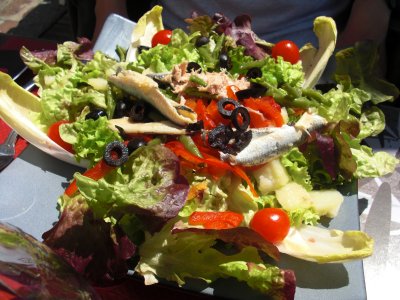
 At this point, David declared that his feet were finished for the day, so he went off to find his way back to the Manoir while CJ and I set off to do other things.
At this point, David declared that his feet were finished for the day, so he went off to find his way back to the Manoir while CJ and I set off to do other things.
We started with lunch at the Hotel Restaurant La Reine Mathilde. CJ had another salad Niçoise, this one with both tuna and anchovies but still with the miserable, watery black olives. I had this rather disorganized but tasty mushroom omelet. It was the first one that wasn't overcooked.
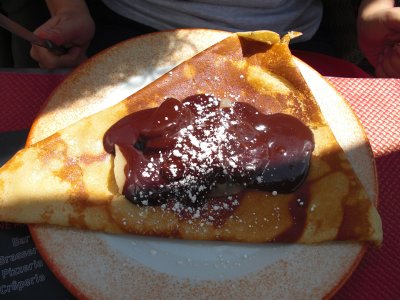
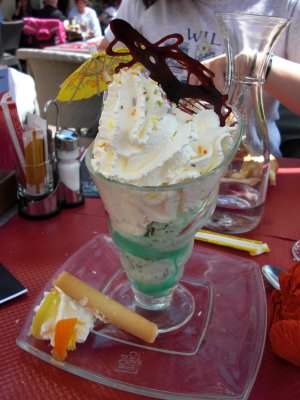 For dessert, CJ ordered a chocolate-banana crepe, hold the whipped cream (why would anyone ever hold the whipped cream?).
For dessert, CJ ordered a chocolate-banana crepe, hold the whipped cream (why would anyone ever hold the whipped cream?).
I had another coupe iceberg, this one decorated within an inch of its life, with a caramel swirl, a parasol, a rolled cookie, orange and lemon slices, and candy sprinkles (the restaurant must get a lot of Brits, for whom no dessert can be considered festive without candy sprinkles).
Our general goal was the Commonwealth war cemetery on the edge of town, on the side nearest the Manoir, but we explored, window shopped, wandered, and read historical markers as we went.
In a shop where a woman was hand painting china, CJ admired a set of six demitasse cups and saucers, white with blue and gold rims, which she went back later and bought. She actually managed to hand carry them home safely on the plane.
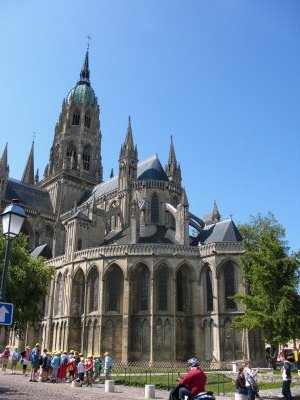
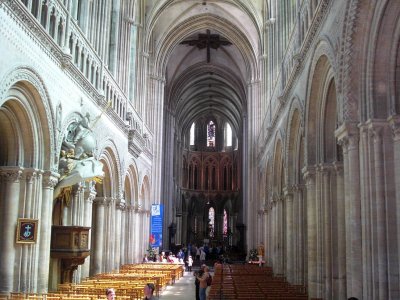 In front of a shoe store, we saw one of those kiddie rides where the parent puts a quarter in the slot (when I was a kid, Sears Roebuck in Durham had a horse that I used to love bobbing up and down on), but this was was a giant shoe. We didn't see it in motion, but presumably the kid would sit inside and the shoe would make stepping motions.
In front of a shoe store, we saw one of those kiddie rides where the parent puts a quarter in the slot (when I was a kid, Sears Roebuck in Durham had a horse that I used to love bobbing up and down on), but this was was a giant shoe. We didn't see it in motion, but presumably the kid would sit inside and the shoe would make stepping motions.
We stopped in to look at the cathedral. It's old, as you can see from the rounded arches in the nave (right). At the left is the view of the chevet (back) end, which I found much more attractive than the main façade.
Polychrome details had been preserved here and there. Some of the keystones of the vaults had colored medallions painted around them, and in the choir, between the vault ribs, a series of saints were portrayed.

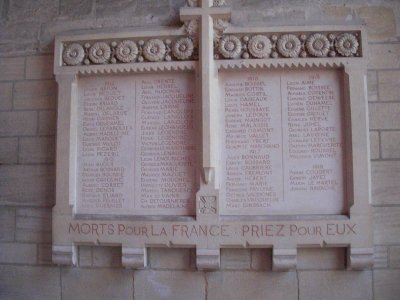 In the crypt, we saw these carved and painted capitals. Most of them were just carved as leave patterns, but some showed figures as well. The paintings were beautiful renderings of angels, each playing a different musical instrument.
In the crypt, we saw these carved and painted capitals. Most of them were just carved as leave patterns, but some showed figures as well. The paintings were beautiful renderings of angels, each playing a different musical instrument.
Back up in the nave, we found the WWI memorial plaque. For once, the list of dead is dwarfed by that from WWII. Also displayed on the walls were a number of commemorative plaques honoring individuals or military units from WWII.
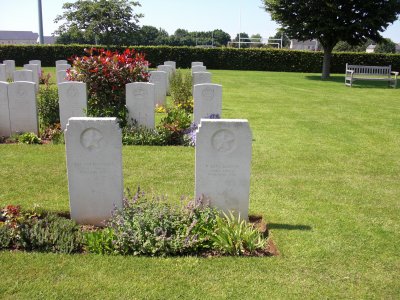
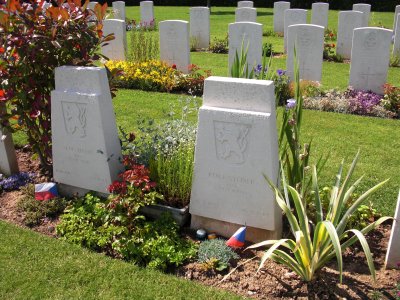 The Commonwealth cemetery at Bayeux, although much larger, was laid out in exactly the same way as the one at Banneville. The graves were arrayed between a memorial building at one end (with a small vault containing the cemetery register and a guest book) and a cross, set in a semicircular bay, at the other. Facing the memorial building was the same monolith, bearing the same Kipling quotation. A flowerbed ornamented each row of graves, with a rosebush after every second stone.
The Commonwealth cemetery at Bayeux, although much larger, was laid out in exactly the same way as the one at Banneville. The graves were arrayed between a memorial building at one end (with a small vault containing the cemetery register and a guest book) and a cross, set in a semicircular bay, at the other. Facing the memorial building was the same monolith, bearing the same Kipling quotation. A flowerbed ornamented each row of graves, with a rosebush after every second stone.
It differed from Banneville in that a number of nationalities were represented. Here, at the left are a pair of Soviet graves, and at the right, two Czech graves. Note how, for each nationality, the top of the stone is distinctively shaped.
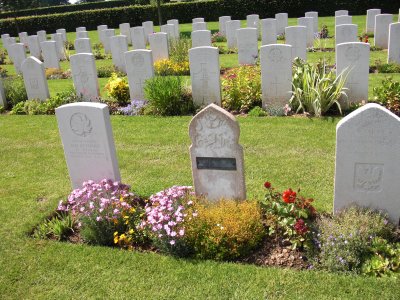
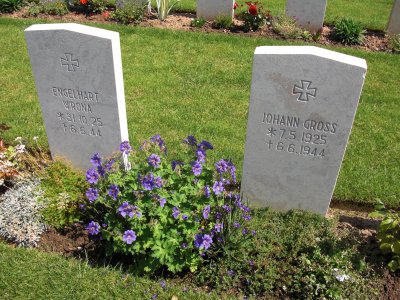 At the left here, among some others of assorted non-British nationality, is the grave of the only muslim. He was an oiler on a British warship.
At the left here, among some others of assorted non-British nationality, is the grave of the only muslim. He was an oiler on a British warship.
Finally, behind the memorial building, in a separate section, were quite a number of German graves, with dates of birth and death. A few just said "Ein Deutscher Soldat" and gave only the date of death.
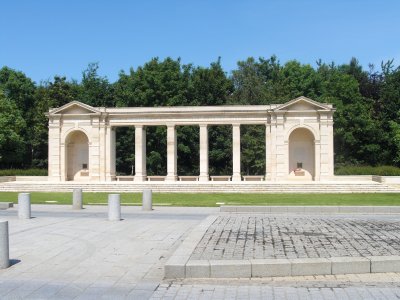
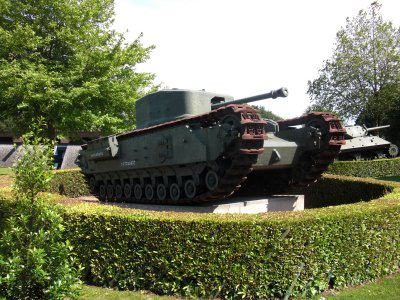 Across the road from the cemetery was this monument to the missing. Across the top, a Latin inscription reads "Nos a guillelmo victi victoris patriam liberavimus"—"We who were conquered by William victorious liberate his homeland."
Across the road from the cemetery was this monument to the missing. Across the top, a Latin inscription reads "Nos a guillelmo victi victoris patriam liberavimus"—"We who were conquered by William victorious liberate his homeland."
Inside an inscription, in French and in English, reads "The names of the soldiers of the British Commonwealth and Empire who fell in the assault upon the Normandy beaches or in the sweep to the Seine but to whom the fortune of war denied a known and honoured grave are recorded upon these walls."
A couple of blocks away was yet another museum, but we were out of time. In front of it were two tanks, including this Churchill Crocodile. What looks like a cannon protruding from the front was actually a flame thrower!
A historical marker nearby explains the origin of the road we had crossed to visit the cemetery. At the time of the invasion, all the roads in the area led through downtown Bayeux, as narrow streets between massive stone buildings. The allies were having great difficulty moving the necessary huge numbers of trucks, tanks, and other vehicles through that bottleneck, so military engineers spent three weeks bulldozing a by-pass around the town—France's first ring road.
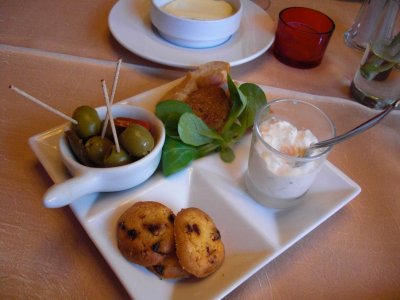
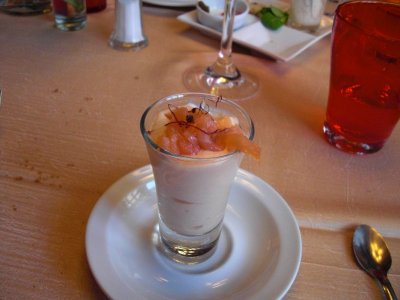 We had dinner at the Lion d'Or, the Golden Lion, within easy walking distance of the Manoir.
We had dinner at the Lion d'Or, the Golden Lion, within easy walking distance of the Manoir.
With the champagne, we were served this little tray of preliminary amouse-bouches: olives, small round toasts with a delicious garlicky fromage blanc, and small, savory black-olive cookies.
The real amuse-bouche was more fromage blanc, this time laced and topped with salmon bits.
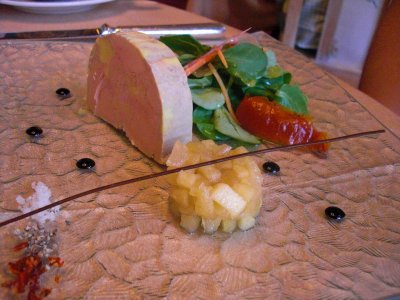
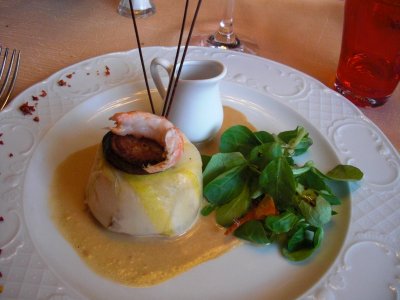 First course, David and CJ: Terrine of duck foie gras with apple and pear chutney with sweet spices.
First course, David and CJ: Terrine of duck foie gras with apple and pear chutney with sweet spices.
First couse, me: "Chartreuse" of andouille de Vire with langoustines and emulsion of cider from Romilly, which turned out to be a mousse of langoutines with langoustines and pieces of andouille embedded in it, all molded in a layer of leek leaves. Delicious!
I think I've finally gotten straight the difference between "veritable andouille de Vire" (from Normandy) and "veritable andouillette de Troyes" (near the champagne country). Both are sausages made of port chitterlings (i.e., stomach and intestines), but they are processed, cooked, and served differently. Andouillettes are generally served hot, in sausage form, and when you cut into them, they tend to fall apart into the pieces that were only held together by the sausage casing, though they're somtimes sliced and serve in pieces. For a photo, for slices included in a salad, see http://bio.fsu.edu/~thistle/blog09/09-06-08.html. For a whole one bursting apart when cut, see http://bio.fsu.edu/~thistle/blog09/09-06-09.html. Andouilles de Vire, on the other hand, are stuffed, smoked for days until entirely black, then simmered long until very tender. They are much more cohesive and are often sliced and served cold. You can see a slice of one on top of my chartreuse. I love both kinds.
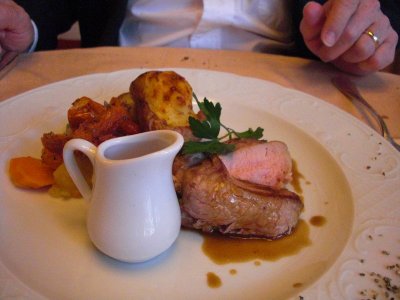
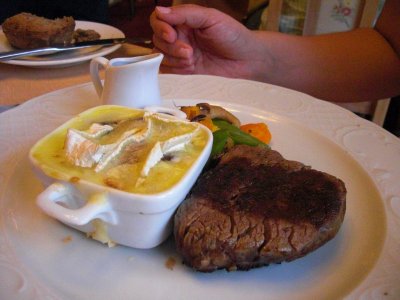 Main course, David: Individual roast of Normandy veal with potatoes (specifically Charlottes) grilled with mimolette d'Isigny. Mimolette is a bright-orange dry cheese, which I've always thought of as Dutch, but apparently it's made in Isigny, where the Normandy butter comes from.
Main course, David: Individual roast of Normandy veal with potatoes (specifically Charlottes) grilled with mimolette d'Isigny. Mimolette is a bright-orange dry cheese, which I've always thought of as Dutch, but apparently it's made in Isigny, where the Normandy butter comes from.
Main course, CJ: Grilled filet of beef with fresh thyme and a small tartifflette with andouille and camembert. She said the beef wasn't as tender as American filet but had great flavor. I wonder whether she knew those chunks under the cheese were andouille.
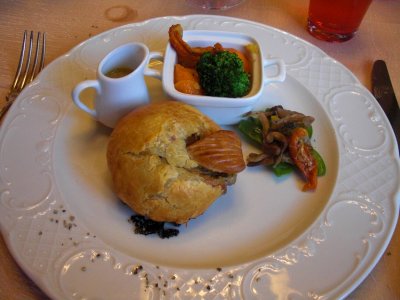
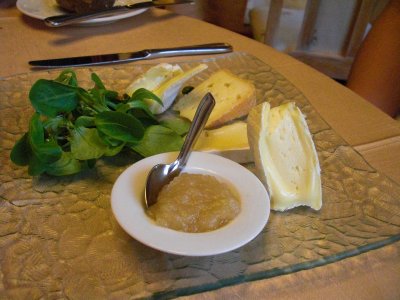 Main course, me: "Fondant" (i.e., melting) lamb stewed with sweet spices and raisins and baked into a spherical pastry crust (with a decorative pastry leaf stuck on the side). Sort of reminiscent of a Moroccan lamb tagine. Very good.
Main course, me: "Fondant" (i.e., melting) lamb stewed with sweet spices and raisins and baked into a spherical pastry crust (with a decorative pastry leaf stuck on the side). Sort of reminiscent of a Moroccan lamb tagine. Very good.
Cheese, David and CJ: The restaurants set assortment of four matured Normandy cheeses with applesauce on the side. Probably Camembert, Livarot, Pont l'Eveque, and Neuchatel.
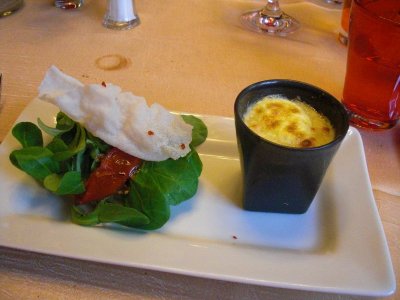
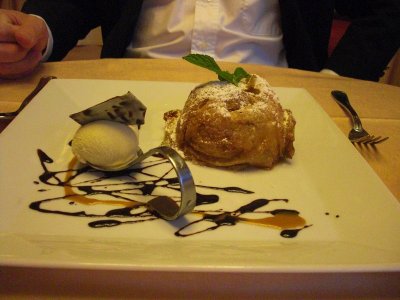 Cheese, me: "Camembert oven-grilled with apple." The put finely diced stewed apple in the bottom of the cut, topped it with camembert, baked it until hot through, and then finished it under the broiler. Pretty good. The white thing balanced on the mache salad is a sort of rice crisp for dipping into the cheese. When it ran out, I fell back on the bread.
Cheese, me: "Camembert oven-grilled with apple." The put finely diced stewed apple in the bottom of the cut, topped it with camembert, baked it until hot through, and then finished it under the broiler. Pretty good. The white thing balanced on the mache salad is a sort of rice crisp for dipping into the cheese. When it ran out, I fell back on the bread.
Dessert, David: A warm apple pastry with Calvados caramel sauce and saffron. Ice cream on the side.
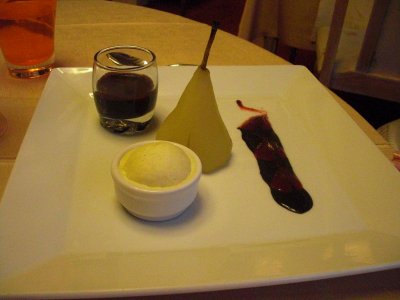
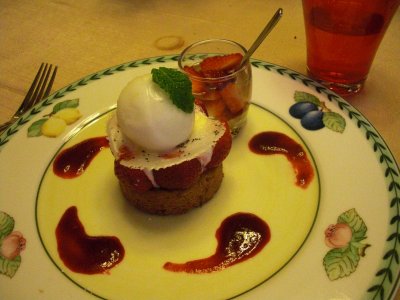 Dessert, CJ: A pear roasted with honey on a brownie with dried fruit and white chocolate verrine. CJ is heavily into pears these days and ordered them at every opportunity (although she wondered aloud why anyone would serve something as sublime as a honey-roasted pear on something as pedestrian as a brownie). This one arrived, sure enough, sitting on top of a brownie, from which nuts prominently protruded. We went it back, and because the pear is apparently actually baked onto the brownie, they couldn't give her a new one without starting over, so they just sliced it carefully off the brownie, set it on a fresh plate, and brought it back. CJ was delighted with it.
Dessert, CJ: A pear roasted with honey on a brownie with dried fruit and white chocolate verrine. CJ is heavily into pears these days and ordered them at every opportunity (although she wondered aloud why anyone would serve something as sublime as a honey-roasted pear on something as pedestrian as a brownie). This one arrived, sure enough, sitting on top of a brownie, from which nuts prominently protruded. We went it back, and because the pear is apparently actually baked onto the brownie, they couldn't give her a new one without starting over, so they just sliced it carefully off the brownie, set it on a fresh plate, and brought it back. CJ was delighted with it.
Dessert, me: "The first strawberries" served on salted-butter shortbread and light cream with lime. The shortbread is the thick disk at the bottom. On that, they piled whole strawberries, which they stuck in place by piping the said lime cream into the spaces between them. On top, they put a white rice-paper pastry wafer and topped that with a ball of lime cream. Extra strawberries in the glass behind. Yummy.
previous entry
List of Entries
next entry

 Here's what the Manoir Sainte Victoire looked like from the outside. I don't know whether the two-windowed section with the flat chimney nearest the camera is part of it, but the garden whose vines are overflowing the wall, the three sections beyond it, and the larger section at right angles to them are. Our room was in the bottom of the leftmost section and CJ's one floor up a spiral stone staircase in the middle section.
Here's what the Manoir Sainte Victoire looked like from the outside. I don't know whether the two-windowed section with the flat chimney nearest the camera is part of it, but the garden whose vines are overflowing the wall, the three sections beyond it, and the larger section at right angles to them are. Our room was in the bottom of the leftmost section and CJ's one floor up a spiral stone staircase in the middle section.
 I'm pretty sure that this vine, in profuse bloom in a corner of the wall (just to the right of the photo above) is a kiwi.
I'm pretty sure that this vine, in profuse bloom in a corner of the wall (just to the right of the photo above) is a kiwi.
 The place really is charming. Each bathroom is decorated with small framed quotations. The one on the left, from Talleyrand, was in ours. It says "Never speak ill of yourself; your friends will do enough of that." The other was in CJ's bathroom (she's in the Miro room) and is from Alphonse Allais (whose book of humorous short stories I had just finished reading. It says, "Don't ask me my age; it changes all the time." Others were (in my translations) "Music begins where the power of words leaves off" (Richard Wagner); "An egotist is someone who doesn't think about me" (Eugène Labiche, 1815-1888); "Elles sont bien noires, les pensées des nuits blanches," (J. de Goncourt, 1810-1870) (meaning "They are very black, the thoughts of white nights"; the French call a sleepless night a "white night"; I assume this is the same Goncourt for whom the literary prize is named), and "Without music, life would be an error" (Friedrich Nietzsche, 1844-1900). Partway up the stairs to CJ's room, in a stone alcove in the wall, was a small collection of books, in French and English, for the reading pleasure of the guests.
The place really is charming. Each bathroom is decorated with small framed quotations. The one on the left, from Talleyrand, was in ours. It says "Never speak ill of yourself; your friends will do enough of that." The other was in CJ's bathroom (she's in the Miro room) and is from Alphonse Allais (whose book of humorous short stories I had just finished reading. It says, "Don't ask me my age; it changes all the time." Others were (in my translations) "Music begins where the power of words leaves off" (Richard Wagner); "An egotist is someone who doesn't think about me" (Eugène Labiche, 1815-1888); "Elles sont bien noires, les pensées des nuits blanches," (J. de Goncourt, 1810-1870) (meaning "They are very black, the thoughts of white nights"; the French call a sleepless night a "white night"; I assume this is the same Goncourt for whom the literary prize is named), and "Without music, life would be an error" (Friedrich Nietzsche, 1844-1900). Partway up the stairs to CJ's room, in a stone alcove in the wall, was a small collection of books, in French and English, for the reading pleasure of the guests.
 At this point, David declared that his feet were finished for the day, so he went off to find his way back to the Manoir while CJ and I set off to do other things.
At this point, David declared that his feet were finished for the day, so he went off to find his way back to the Manoir while CJ and I set off to do other things. 
 For dessert, CJ ordered a chocolate-banana crepe, hold the whipped cream (why would anyone ever hold the whipped cream?).
For dessert, CJ ordered a chocolate-banana crepe, hold the whipped cream (why would anyone ever hold the whipped cream?). 
 In front of a shoe store, we saw one of those kiddie rides where the parent puts a quarter in the slot (when I was a kid, Sears Roebuck in Durham had a horse that I used to love bobbing up and down on), but this was was a giant shoe. We didn't see it in motion, but presumably the kid would sit inside and the shoe would make stepping motions.
In front of a shoe store, we saw one of those kiddie rides where the parent puts a quarter in the slot (when I was a kid, Sears Roebuck in Durham had a horse that I used to love bobbing up and down on), but this was was a giant shoe. We didn't see it in motion, but presumably the kid would sit inside and the shoe would make stepping motions.
 In the crypt, we saw these carved and painted capitals. Most of them were just carved as leave patterns, but some showed figures as well. The paintings were beautiful renderings of angels, each playing a different musical instrument.
In the crypt, we saw these carved and painted capitals. Most of them were just carved as leave patterns, but some showed figures as well. The paintings were beautiful renderings of angels, each playing a different musical instrument.
 The Commonwealth cemetery at Bayeux, although much larger, was laid out in exactly the same way as the one at Banneville. The graves were arrayed between a memorial building at one end (with a small vault containing the cemetery register and a guest book) and a cross, set in a semicircular bay, at the other. Facing the memorial building was the same monolith, bearing the same Kipling quotation. A flowerbed ornamented each row of graves, with a rosebush after every second stone.
The Commonwealth cemetery at Bayeux, although much larger, was laid out in exactly the same way as the one at Banneville. The graves were arrayed between a memorial building at one end (with a small vault containing the cemetery register and a guest book) and a cross, set in a semicircular bay, at the other. Facing the memorial building was the same monolith, bearing the same Kipling quotation. A flowerbed ornamented each row of graves, with a rosebush after every second stone.
 At the left here, among some others of assorted non-British nationality, is the grave of the only muslim. He was an oiler on a British warship.
At the left here, among some others of assorted non-British nationality, is the grave of the only muslim. He was an oiler on a British warship.
 Across the road from the cemetery was this monument to the missing. Across the top, a Latin inscription reads "Nos a guillelmo victi victoris patriam liberavimus"—"We who were conquered by William victorious liberate his homeland."
Across the road from the cemetery was this monument to the missing. Across the top, a Latin inscription reads "Nos a guillelmo victi victoris patriam liberavimus"—"We who were conquered by William victorious liberate his homeland."
 We had dinner at the Lion d'Or, the Golden Lion, within easy walking distance of the Manoir.
We had dinner at the Lion d'Or, the Golden Lion, within easy walking distance of the Manoir.
 First course, David and CJ: Terrine of duck foie gras with apple and pear chutney with sweet spices.
First course, David and CJ: Terrine of duck foie gras with apple and pear chutney with sweet spices.
 Main course, David: Individual roast of Normandy veal with potatoes (specifically Charlottes) grilled with mimolette d'Isigny. Mimolette is a bright-orange dry cheese, which I've always thought of as Dutch, but apparently it's made in Isigny, where the Normandy butter comes from.
Main course, David: Individual roast of Normandy veal with potatoes (specifically Charlottes) grilled with mimolette d'Isigny. Mimolette is a bright-orange dry cheese, which I've always thought of as Dutch, but apparently it's made in Isigny, where the Normandy butter comes from.
 Main course, me: "Fondant" (i.e., melting) lamb stewed with sweet spices and raisins and baked into a spherical pastry crust (with a decorative pastry leaf stuck on the side). Sort of reminiscent of a Moroccan lamb tagine. Very good.
Main course, me: "Fondant" (i.e., melting) lamb stewed with sweet spices and raisins and baked into a spherical pastry crust (with a decorative pastry leaf stuck on the side). Sort of reminiscent of a Moroccan lamb tagine. Very good.
 Cheese, me: "Camembert oven-grilled with apple." The put finely diced stewed apple in the bottom of the cut, topped it with camembert, baked it until hot through, and then finished it under the broiler. Pretty good. The white thing balanced on the mache salad is a sort of rice crisp for dipping into the cheese. When it ran out, I fell back on the bread.
Cheese, me: "Camembert oven-grilled with apple." The put finely diced stewed apple in the bottom of the cut, topped it with camembert, baked it until hot through, and then finished it under the broiler. Pretty good. The white thing balanced on the mache salad is a sort of rice crisp for dipping into the cheese. When it ran out, I fell back on the bread.
 Dessert, CJ: A pear roasted with honey on a brownie with dried fruit and white chocolate verrine. CJ is heavily into pears these days and ordered them at every opportunity (although she wondered aloud why anyone would serve something as sublime as a honey-roasted pear on something as pedestrian as a brownie). This one arrived, sure enough, sitting on top of a brownie, from which nuts prominently protruded. We went it back, and because the pear is apparently actually baked onto the brownie, they couldn't give her a new one without starting over, so they just sliced it carefully off the brownie, set it on a fresh plate, and brought it back. CJ was delighted with it.
Dessert, CJ: A pear roasted with honey on a brownie with dried fruit and white chocolate verrine. CJ is heavily into pears these days and ordered them at every opportunity (although she wondered aloud why anyone would serve something as sublime as a honey-roasted pear on something as pedestrian as a brownie). This one arrived, sure enough, sitting on top of a brownie, from which nuts prominently protruded. We went it back, and because the pear is apparently actually baked onto the brownie, they couldn't give her a new one without starting over, so they just sliced it carefully off the brownie, set it on a fresh plate, and brought it back. CJ was delighted with it.